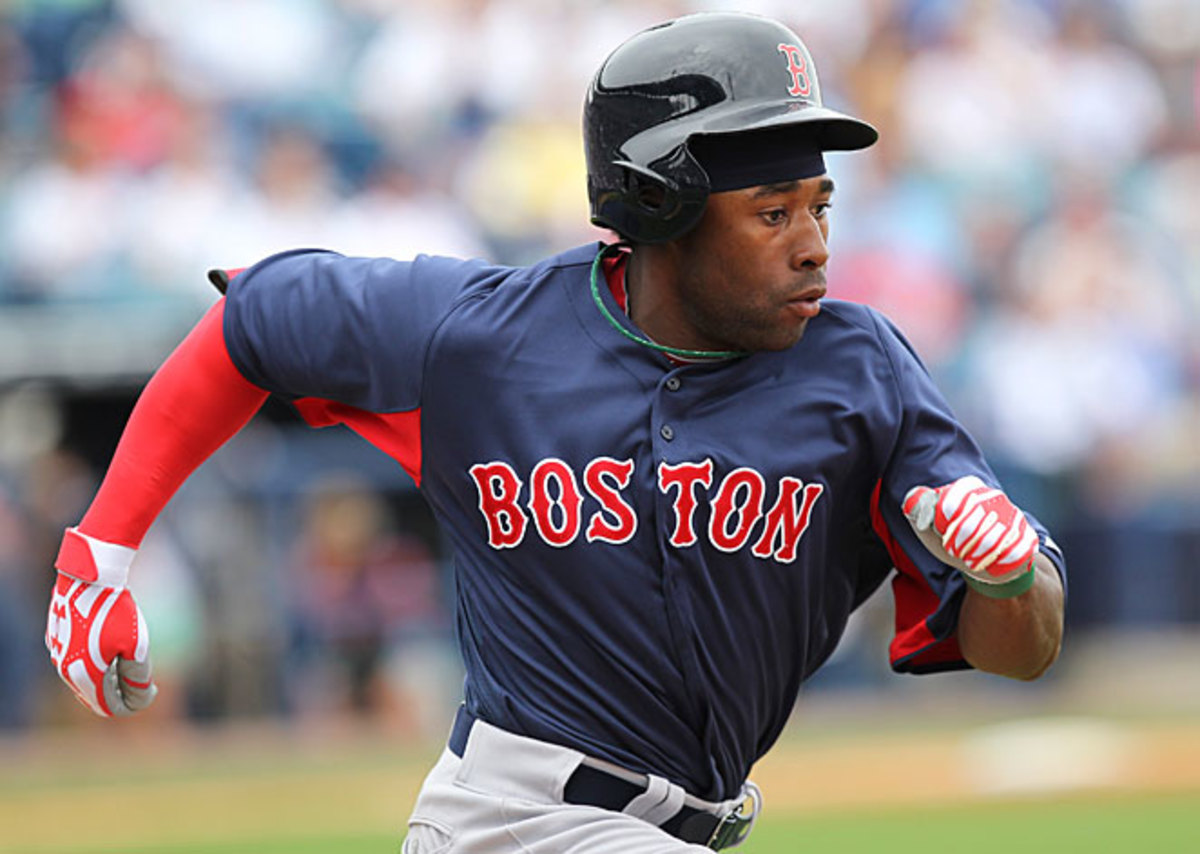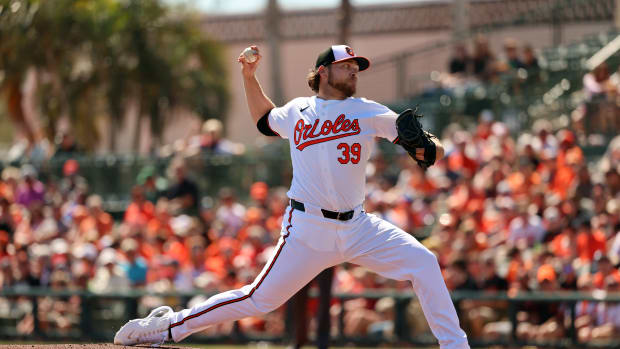Red Sox returning to winning formula, if not winning ways
For more of SI.com's 2013 Major League Baseball season preview coverage, click here.
Boston Red Sox
2012 Record: 69-93, fifth in AL East
2013 Projection: 77-85, fifth in AL East
Even by St. Patrick's Day, March 17, it was clear that Jackie Bradley, Jr., was not yet entirely used to the attention. The lockers at his end of the Red Sox' spring training clubhouse in Fort Myers, Fla., were mostly cleared out, their former occupants sent back to minor league camp, but the 22-year-old Bradley was still there, and one of the members of Boston's famously deep media corps approached him. The next time Bradley turned around, there were three reporters standing next to him. The next time, there were a dozen. Bradley's eyes grew wide, still not accustomed to how quickly they could swarm, but he was generally as he had been all spring long: unflustered.
"I can just tune it out," said Bradley, a first-round draft pick in 2011, of the attention being devoted to him during an exhibition season in which, through March 25, he had hit .444, with an on-base percentage of .523, and looked like nothing less than the second coming of Tony Gwynn. "Just keep playing. You can see it, but you don't necessarily have to have a reaction to it."
Bradley has become the central story in Sox camp for a few reasons. One, in the words of new manager John Farrell: "Can't deny the fact that he's having a hell of a spring."
"For a young player who has just over a year in professional baseball, he's got a very consistent approach at the plate," Farrell continues. "He's got a quiet confidence about him, and a quiet competitiveness, so he looks like he's been playing in the big leagues for five to seven years. His routes and reads in the outfield are outstanding. He's a polished player for a young guy."
The other reason for the fascination with Bradley is what he represents, which is the dawning for a new era for a club that has not made the playoffs since 2009, and lost more games last year (93) than it had in any season since 1965. "Last year's last year," says second baseman Dustin Pedroia. "This is a new group. We're more focused on what we're doing now, and we're not looking back."
If there was anything positive to take away from last season for now second-year general manager Ben Cherington, it was that it once and for all showed everyone that his club needed to go in a new direction, after a major roster overhaul which was helped by the Dodgers, who traded for the mammoth contracts of Josh Beckett, Carl Crawford and Adrian Gonzalez late last August.
"It really forced us, more than we would normally anyway, to take a very hard look at ourselves, to be accountable for the decisions that had led us to that point, and to take a very hard look at what we needed to do better to put the team back in a position to be successful over a sustained period," says Cherington.
That hard look resulted in the firing of Bobby Valentine after one tumultuous year as manager and the bringing in of Farrell, who had been Boston's pitching coach between 2007 and 2010, spent the past two seasons as the manager of the Blue Jays and will be counted on to minimize the Valentine era's distractions. "I think -- and I think John shares this -- that the focus needs to be on the field as much as possible, on how we're preparing for a game, how we're executing during the game," says Cherington.
Then there are all the new players. This year's 25-man Opening Day roster will likely include just seven players who opened the season active with the Red Sox last season: starters Jon Lester, Clay Buchholz and Felix Doubront, reliever Alfredo Aceves, catcher Jarrod Salatalamacchia, centerfielder Jacoby Ellsbury and Pedroia (although several holdover Sox like Andrew Bailey, John Lackey and David Ortiz were then or are now on the disabled list).
"The clubhouse has gone through a complete remake," says Farrell. "It's a group of guys that love to play the game. The focus and attention is in between the lines, hopefully there will be fewer distractions than might otherwise have been the case."
Cherington focused his off-season attention and dollars on hardworking, high character additions like pitcher Ryan Dempster, designated hitter Jonny Gomes, catcher David Ross, catcher/first baseman Mike Napoli and centerfielder Shane Victorino.
"When we've been really good, we've been disciplined in a lot of different ways, in a lot of different manifestations of that word," Cherington says. "It can relate to player acquisitions, the way we play on the field, decisions related to contracts. For a long period of time we were a pretty disciplined organization that put a lot of resources into player talent, and played disciplined baseball on the field. I think we started to get away from that a little bit, and certainly took our medicine as a result."
One hope is that a culture change will have a positive effect on some of the veterans who do remain, particularly in a rotation that last year combined for a 5.19 ERA, baseball's fourth worst. "The biggest impact we could make in the rotation was just to allow the guys that were here to get back to closer to what they'd done before," says Cherington.
In particular, staff No. 1 Jon Lester, who between 2008 and 2011 had a 65-32 record with an 3.33 ERA, scuffled all season long, going 9-14 with an ERA of 4.82. The addition of Dempster, as steadying an influence as you will find, should help, as should the return of Farrell, under whose tutelage Lester cut his teeth.
"You could tell there were some changes that took place in his delivery that really affected the flight of the ball through the strike zone," says Farrell of what he observed of Lester last year, from an opposing dugout. "He'd get a little bit more spread out, his fastball was a little bit more flat. I think it showed up in the extra base hits he allowed. The difference of six to eight inches of elevation in the strike zone is the difference between a ball being put on the ground and being driven out of the ballpark. We've addressed things with his delivery, and to his credit he's taking them out to the mound and repeating them."
Indeed, Lester has arguably been the majors' single most impressive pitcher in spring training, as through 20 innings he had an ERA of 0.90, a batting average against of .092 and 16 strikeouts.
It is somewhat hard to imagine that in a stacked AL East the Red Sox will add the 20 to 25 wins they will need to reach the playoffs. Not that they consider themselves an underdog. "Got a $170 million payroll -- you know what I mean?" says Pedroia.
But this is a season in which the Sox will seek to prove that they really have pressed the re-set button, and now have the right kind of veterans and the young, energetic contributors they've recently lacked (the last member of the club to receive even a single Rookie of the Year vote was Ellsbury, back in 2008). There's Bradley, who never seems to make an out, but sooner or later there will be 20-year-old slugger Xander Bogaerts and also hard-throwing pitchers Rubby de la Rosa and Allen Webster, both of whom were acquired in the Dodgers trade.
"To have that pipeline, being able to identify not just guys that are going to be able to play in the big leagues but starting players and front end of the rotation type of pitchers -- we're in a healthy spot, given the flexibility at the big league level and what's coming underneath," says Farrell. "We're positioned pretty well right now."
Last season's ailments might not be instantly cured, but it does look as if a cure is coming.
Biggest Addition: Ryan Dempster
The Red Sox gave the 35-year-old Dempster $26.5 million over two years not just to mentor younger starters like Lester and Buchholz, but to throw quality innings of his own -- at least 180 of them, says Farrell. Last season, Dempster went 5-5 with a 2.25 ERA in 16 starts with the Cubs, and was 7-3 with a 5.09 ERA in a dozen outings after being traded to Texas, but he rejects the idea that he experienced a difficult transition to the American League in any prolonged way.
"It's funny, everyone talks about that -- 'Oh, he struggled in the AL,'" he says. "I gave up 16 runs in two of my first three starts. You can't take starts out -- but you take them out and the numbers were a lot better than what they finished up at. After I got those two out of the way, I felt like I pitched a lot better."
In fact, if you remove early outings against the Angels and Yankees in which he gave up eight runs apiece, Dempster's AL ERA was a reasonable 3.55.
Biggest Loss: Cody Ross
Ross was one of the few bright spots in Boston last year, a good-natured clubhouse presence who played solid defense in the outfield and produced at the plate: he slugged 22 homers, drove in 81 runs and had an OPS of .807. Yet the Sox essentially replaced him with Victorino, who will cost some $13 million more over the next three years (Ross signed a three year, $26 million deal with the Diamondbacks), who has a similar personality and plays even better defense, but, at the same age as Ross (32), had an OPS last season that was more than 100 points lower. In an offseason full of sensible changes, this seems to have been a questionable one.
What They Do Best: Pitch out of the bullpen
Cherington's December trade for Joel Hanrahan, who saved a total of 76 games as an All-Star the last two years for Pittsburgh, was the biggest move in an offseason in which the bullpen (19th in the majors last season with a 3.88 ERA) was significantly fortified. Bailey, the erstwhile closer who spent much of last year on the disabled list, instantly becomes perhaps the best setup man in the league, and the free agent signing of Koji Uehara also should not be overlooked. Uehara does not throw particularly hard, but his control is extraordinary: In a season-and-a-half in Texas he struck out 66 batters while walking four, and his career strikeout-to-walk ration of 7.97:1 is the best in history among pitchers who have thrown more than 70 innings.
What They Do Worst: Go left
The Sox will enter the season with five players on the disabled list, and all five either throw or bat lefthanded: relievers Craig Breslow (sore shoulder) and Franklin Morales (sore lower back), and designated hitter David Ortiz (sore Achilles), shortstop Stephen Drew (concussion) and outfielder Ryan Kalish (shoulder surgery). That means that the bullpen will at first likely feature only one southpaw, Andrew Miller, and the lineup just two regulars who excel from the left side, Ellsbury and Saltalamacchia. Consider that another motivation for the Sox to give the Jackie Bradley Jr. era (he's a lefty, after all) an early start.
Bottom Line
A return to the playoffs wouldn't be entirely shocking, but more likely is that 2013 will be a season for the Red Sox to firmly establish that they are back on the right long-term track, even if they end up home for their fourth straight October.




































